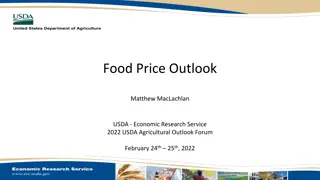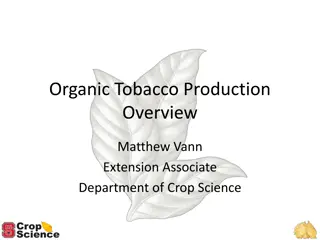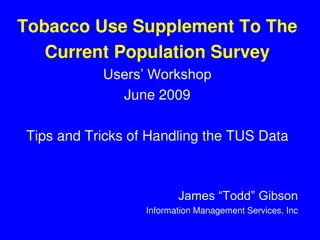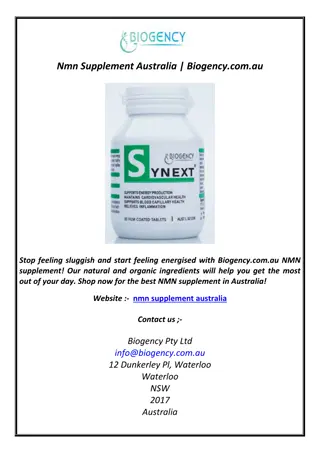Insights into Organic Food and Supplement Market Trends
Significant revenue increases in the organic food market, particularly in organic produce, reflecting changing consumer preferences towards healthier and more sustainable options. The market is expanding to include younger, wealthier demographics, with supplements also playing a vital role in the health and wellness industry. The rising popularity of plant-based foods further indicates a shift towards more conscious consumption habits.
Download Presentation

Please find below an Image/Link to download the presentation.
The content on the website is provided AS IS for your information and personal use only. It may not be sold, licensed, or shared on other websites without obtaining consent from the author.If you encounter any issues during the download, it is possible that the publisher has removed the file from their server.
You are allowed to download the files provided on this website for personal or commercial use, subject to the condition that they are used lawfully. All files are the property of their respective owners.
The content on the website is provided AS IS for your information and personal use only. It may not be sold, licensed, or shared on other websites without obtaining consent from the author.
E N D
Presentation Transcript
Significant Revenue Increases 2018 was the first year total organic sales exceeded $50 billion, or $52.5 billion, a 6.3% increase, or more than 50% of the 4.0% increase for the entire grocery market. Nonetheless, recent annual increases have been moderating. The organic food sub-category increased 5.9% to $47.9 billion, compared to a 2.3% increase for all grocery foods, and the organic non-foods sub-category increased even more, or 10.6% to $4.6 billion, compared to 3.7% for all grocery non-food items. Although self-serving, the Organic Trade Association (OTA) is not incorrect when it declares organics products are now quite common in all grocery establishments: supermarkets, mass merchandisers, warehouse clubs, convenience stores and online.
Produce Continues to Be the Organic Leader The OTA reported 2018 organic produce sales (which include fresh, frozen, canned and dried products) increased 5.6% to $17.4 billion, or 36.3% of all 2018 organics sales and 14.6% of all fruits and vegetables (non-organic and organic). The Organic Produce Network (OPN)/Nielsen reported an increase of 8.6%, or a total of $5.6 billion, for fresh organic produce only, which was 26% of all organic sales and 10% of all sales of fruits and vegetables. An OTA spokesperson said the USDA Organic seal is attracting more attention and engendering trust among consumers as well as their interest in clean labeling, fewer chemicals, supply-chain transparency, sustainability and local sourcing.
Organic Consumers Skew Younger and Wealthier Historically, organic consumers were predominately vegetarians and vegans; however, Gallup reported during August 2018 that vegetarians, as a percentage of the population, hasn t changed much during the past 20 years, or 6% during 1999 and 5% during 2018. As organic products have entered the mainstream, the market has expanded to include households with above-average incomes and children younger than 18 and Millennials and Gen Xers, but these shoppers don t buy organic regularly. Higher prices are generally the largest barrier to market expansion, especially among lower-income households, as organic foods and beverages cost approximately 7.5% more than their non-organic equivalents during 2018; however, prices are declining.
Supplements Are Still an Important Source of Healthy Living According to a May 2019 article from New Hope Network, 2018 US supplement sales increased 6%, or a total of $46 billion, following a 5.4% increase for 2017. The sector is forecast to exceed $50 billion for the first time during 2020. Although they generate less than 1/20thof the sales of probiotics ($2 billion for 2018), prebiotic supplements ($96.1 million for 2018) doubled its sales for the third consecutive year while synbiotic supplements (a blend of pre- and probiotics) increased 16.2%. The supplements market is benefiting from Millennials and other young adults whole body/mind approach to health, compared to older adults who tend to assess their health according to various metrics: weight, blood pressure, sugar count, etc.
The Growing Popularity of Plant-Based Foods Based on Nielsen retail sales data, total sales of plant- based foods were $3.7 billion for the 52 weeks ending 8/11/18, a 17% increase YOY. The largest increases were creamers, 62%; yogurt, 55%; cheese, 41%; and ice cream/frozen novelties, 40%. A total of $17.1 billion was invested in the industry during 2018, Interest has increased with the media coverage of Beyond Meat s IPO and tripling of Q1 2019 revenues to $40.2 million and the addition of the Impossible Burger at Burger King. Another measurement of the increasing popularity of plant-based foods is found in additional Nielsen data that reveals a 37% household-penetration rate for plant- based milk and a 12% household-penetration rate for plant-based meat during 2018.
Whos Buying Plant-Based Foods? In its State of the Industry Report, The Good Food Institute (GFI) revealed 32% of US consumers are flexitarians, or 6% who rarely and 26% who sometimes eat meat. Plus, 30% are reducing their meat consumption, or 7%, much less, and 23%, slightly less. The profile of plant-based milk consumers are households with children younger than 6, incomes of more than $70,000, college educated, in suburban and urban neighborhoods and a head of household 25 49. Although households that purchase and consume plant-based meat products are very similar to those who consume plant-based milk products, more of them are Millennial female heads of households and have household incomes exceeding $70,000.
Advertising Strategies With spending for FMCG organic products increasing the most among African American and Latinx American households, retailers will benefit by consciously targeting these ethnic audiences in their advertising messages/content. The prices of organic products have been decreasing and are forecast to continue, which provides an opportunity for retailers to position more of these products as affordable for lower-income households. Organic retailers may want to consider a Healthy Living Carnival or Celebration as a weekend promotion, combining special prices on organics with in-store presentations from nutritionists and other professionals about easy methods to improve the health of meals.
New Media Strategies To generate more interest and sales among lower- income households for organic products, retailers can use social media postings to show how occasionally substituting a non-organic with an organic product won t negatively affect their budgets. Influencer marketing is an excellent method to increase interest and sales of organic products. Retailers should invite loyal and enthusiastic customers to post regular videos on social media with recipes and other tips in exchange for a discount or special coupon. Organic retailers can generate brand awareness with community-involvement projects, such as providing food pantries, soup kitchens and Meals on Wheels with occasional food contributions as well as employees volunteering; all of which becomes social media content.























